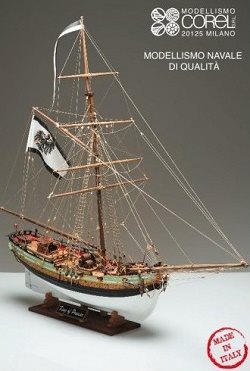Corel King Of Prussia 1:42
£202.00 each
Corel King of Prussia
British smuggler ship from the 18th century.
Historical background
John Carter, who liked to be called the "King of Prussia," was probably the most famous and clever of smugglers in Cornwall in the south of England. His nickname - by the way, the "Prussia Cove" between Penzance and Portleven her name owes its name - he wore from an early age, because in the war games with his brothers John always wanted to be Frederick the Great, King of Prussia.
Carter's domination of the sea lasted from 1777 to 1807. After his death, his stepson William Richards followed in the footsteps of the notorious smuggler; "Prussia Cove" maintained the reputation as a dangerous smuggling test.
Almost everything we know about John Carter today is based on legends told in the field. John and his brother Harry were undisputed leaders of all smugglers in Cornwall at the time. Despite his dubious career, Carter was known to be extremely correct in his business, and legendary was the skill with which he knew how to navigate his Hoy-type ship. Customs officials took advantage of a few days of absence; they confiscated a cargo freshly arrived from France and took the goods to the customs warehouses. When Carter was back, he shuffled his men around, broke into the halls of the Customs and retrieved the goods, leaving all other things there, which were not "his".
Once the Hoy Carters was hounded by a sloop; Carter steered his ship in cold blood through a narrow passageway of the reef. Because of the low tide, the pursuers ran aground and could not use their cannons against the smugglers under John Carter, who made undisturbed with the booty from the dust. Hoy's had a hull of the type "Carvel", where the planking side by side is applied running, resulting in a smooth and flowing surface. The sloops, on the other hand, had a so-called "clinker" hull with planks applied one above the other; While this was conducive to tightness, it did provide the ship with a certain amount of inertia, which meant that speed had to be taken out of the way when the waves swelled. The hull of the Hoys was also wider and the keel was less deep in the water, so that one could maneuver with these ships also near the coast and in canals, where other ships would have run aground.
The answer to the question lies in the design and construction of the ship. Unlike the hugely popular Sloops, which were mostly constructed of durable and heavy English oak, the Hoys were crafted from fir wood, which was also waterproof, but cheaper and, above all, lighter. Light wood meant less weight and thus greater speed. The hulls of the two types of ships were constructed differently: The Hoys had a hull of the type "Carvel", in which the planking is applied running side by side, resulting in a smooth and flowing surface. The sloops, on the other hand, had a so-called "clinker" hull with planks applied one above the other; While this was conducive to tightness, it did provide the ship with a certain amount of inertia, which meant that speed had to be taken out of the way when the waves swelled. The hull of the Hoys was also wider and the keel was less deep in the water, so that one could maneuver with these ships also near the coast and in canals, where other ships would have run aground.
The Type Hoy varies in size - there are equally small Hoys with only one deck as well as large cannon-equipped ships for a crew of about 50 men, equipped with a cargo hold for large loads. Another advantage of the Hoys was the nature of their sails. The sloops had triangle sails in front and behind and a long bowsprit. At first glance, the sails looked pretty similar to the Hoys, but in more detail it was more mature and supported by square sails. In this way resulted in a 25% larger sail area, in which the wind could be caught.
Specifications:
Scale 1:42
Length: 745mm
Height: 630mm
Corel Wooden Model Ship Kits
Since 1971 the Corel "fleet" has been sailing the seas!
COREL has been making model kits for period and modern ships since 1971, and enthusiasts will know about their high quality, the best materials, almost no plastic parts, good quality wood in various shades, cast and gilded metal decorations, photoetched parts in brass or copper, and everything provided for easy assembly of the model.Every modeller will appreciate our "fully pre-cut" system. Wherever possible all parts are pre-cut and ready for assembly. You will appreciate our new catalogue. All COREL model boat products are listed and illustrated.Our products will give pleasure and new impetus to enthusiasts at home and abroad.
